Ethernet cable wiring is the process of installing and configuring cables for network connectivity. Proper wiring ensures reliable, high-speed communication between devices, minimizing interference and downtime. It serves as the backbone for local area networks (LANs), enabling efficient data transfer and supporting various online services. Understanding Ethernet cable wiring is essential for both home and commercial environments, ensuring robust connectivity for internet access, resource sharing, and more.
What Is Ethernet Cable Wiring?
Ethernet cable wiring refers to the process of installing and configuring Ethernet cables to connect devices within a network. It involves using twisted-pair cables, such as Cat5e, Cat6, or Cat7, to establish wired connections between computers, routers, switches, and other network devices. Proper wiring ensures reliable data transmission, minimizes interference, and supports high-speed communication. Ethernet cables are categorized by their bandwidth capacity and are fundamental for both home and office networks, enabling internet access, file sharing, and communication services.
Importance of Proper Ethernet Cable Wiring
Proper Ethernet cable wiring is crucial for ensuring reliable, high-speed network connections. It minimizes signal interference, reduces data packet loss, and optimizes performance. Correct wiring ensures consistent connectivity, supporting both home and office environments. In offices, it enables smooth communication and data transfer, while in homes, it supports online activities and device connectivity. Proper wiring also future-proofs your network, accommodating upgrades and scalability. Investing in correct installation reduces downtime, enhances security, and ensures long-term reliability, making it essential for efficient and stable network operations.
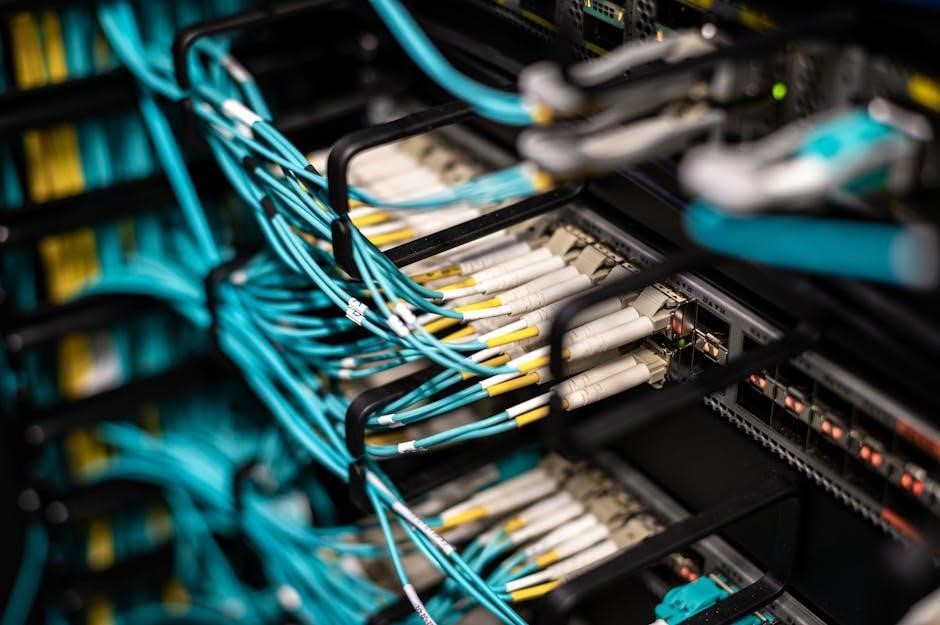
Planning and Preparation
Assess network requirements, create a detailed diagram, and determine cable lengths and paths. Gather necessary tools and materials, ensuring compatibility and readiness for installation.
Assessing Network Requirements
Begin by identifying the number of devices, their locations, and bandwidth needs. Determine the required speed and reliability for your network. Consider the physical layout of the space, including walls, floors, and obstacles. Assess existing infrastructure, such as routers and switches, to ensure compatibility. Evaluate future scalability to accommodate potential growth. This step ensures your Ethernet cable wiring meets current demands while preparing for future upgrades, avoiding costly rework and ensuring optimal performance across all connected devices.
Creating a Network Diagram
A network diagram visually maps your Ethernet cable setup, detailing devices, connections, and cable pathways. Use tools like Lucidchart, Visio, or even Excel to design it. Include device locations, cable lengths, and port assignments. Label each component clearly for easy reference. This diagram guides installation, prevents wiring errors, and simplifies future modifications. It ensures cables are logically routed, avoiding interference and optimizing performance. A well-planned diagram saves time and reduces complications during setup and maintenance, making it essential for both home and office networks.
Determining Cable Length and Path
Accurately measure the distance between devices to determine the required Ethernet cable length. Account for physical obstacles like walls, floors, and ceilings. Choose the shortest path to minimize cable waste and interference. Ensure cables are routed away from power lines and high-traffic areas to reduce signal degradation. Label each cable with its length and purpose for easy identification. Plan the cable path to allow flexibility for future upgrades or reconfigurations. Proper routing ensures reliable connectivity, reduces maintenance, and optimizes network performance. Measure twice to avoid excess cable or shortages, ensuring a clean and efficient installation.
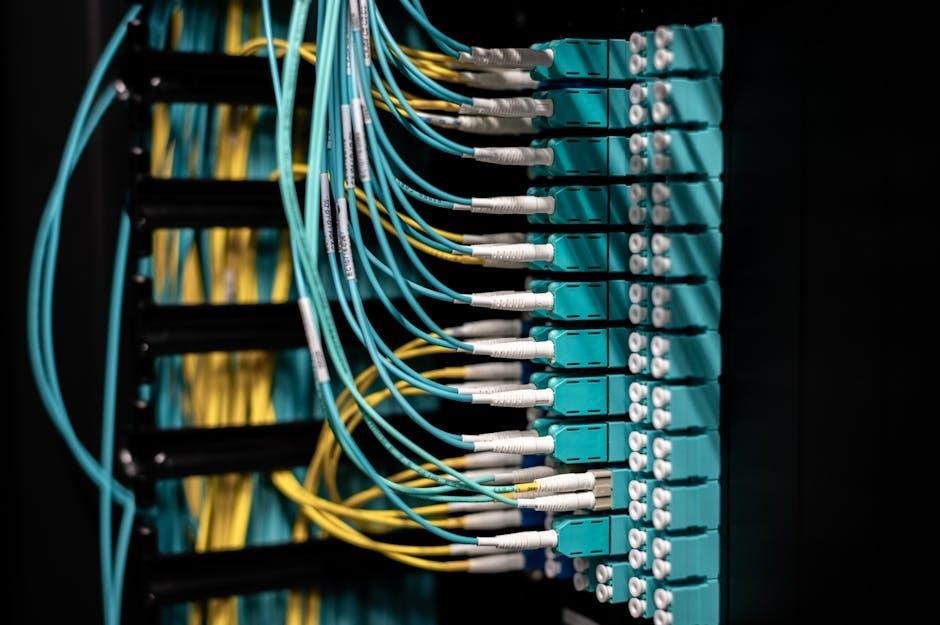
Tools and Materials Needed
Ethernet cable wiring requires essential tools like cable cutters, strippers, and crimpers for precise cable preparation. Testing tools, such as cable testers and multimeters, ensure connectivity and performance accuracy.
Essential Hand Tools
For Ethernet cable wiring, essential hand tools include cable cutters, wire strippers, and crimpers. Cable cutters trim cables to desired lengths, while wire strippers remove insulation without damaging wires. Crimpers securely attach connectors to cable ends, ensuring proper connections. Additionally, a punch-down tool is useful for installing cables in patch panels or keystone jacks. These tools are crucial for precise cable preparation and termination, ensuring reliability and performance in network setups. Investing in high-quality, durable tools is vital for achieving professional results and maintaining safety during installation processes.
Testing and Measurement Tools
Testing and measurement tools are crucial for ensuring Ethernet cable wiring integrity. Cable testers verify connectivity and wiring accuracy, while multimeters measure voltage and current to detect faults. Network cable testers assess data transmission performance, identifying issues like open circuits or short circuits. These tools help troubleshoot installation errors and validate cable performance. Regular testing ensures reliable network operation and minimizes downtime. By using these tools, installers can guarantee cables meet required standards for speed and data integrity, ensuring optimal network performance and longevity.
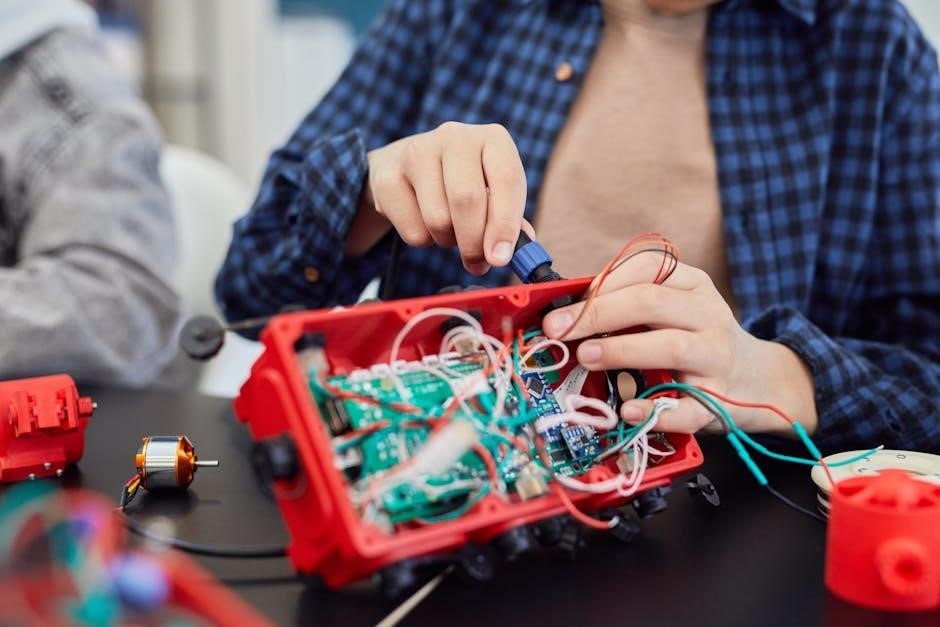
Cable Selection
Selecting the right Ethernet cable is vital for optimal network performance. Categories like Cat5e, Cat6, and Cat7 offer varying speeds and frequencies, ensuring reliable data transmission. Always choose cables that match your network requirements for speed, distance, and bandwidth needs. Consider future-proofing by opting for higher categories to support upcoming technologies and applications. Environmental factors like indoor or outdoor use also influence cable choice, ensuring durability and compliance with specific conditions.
Types of Ethernet Cables
Ethernet cables are categorized into different types based on their performance and capabilities. Cat5e cables offer speeds up to 1 Gbps and are suitable for small networks. Cat6 cables support up to 10 Gbps, making them ideal for high-speed applications. Cat7 cables provide even faster speeds and are future-proof for advanced networks. Additionally, there are shielded and unshielded versions, with shielded cables offering better protection against electromagnetic interference. Fiber optic cables are another option, providing superior speed and reliability over long distances. Each type is designed for specific network requirements, ensuring optimal performance and connectivity.
Choosing the Right Category
Selecting the appropriate Ethernet cable category depends on your network’s speed and performance requirements. Cat5e cables are suitable for basic home networks, supporting up to 1 Gbps. For medium-sized networks requiring higher speeds, Cat6 cables are ideal, offering up to 10 Gbps. Cat7 cables are recommended for future-proof installations, supporting speeds up to 40 Gbps. Consider factors like budget, network size, and interference levels when deciding. Shielded cables are better for environments with high electromagnetic interference. Always match your cable category to your network hardware for optimal performance and reliability.
Color Coding and Labeling
Ethernet cables use color coding to simplify wiring, with standardized patterns like T568A and T568B for RJ-45 connectors. These color codes ensure consistent wiring and minimize errors. Proper labeling is crucial for network organization, allowing easy identification of cable purpose and destination. Labels should include information like port numbers, device names, and cable categories. Consistent labeling enhances maintainability and reduces downtime during troubleshooting. Use high-quality labels and printers to ensure durability and readability over time. Clear labeling practices are essential for both home and professional networks, promoting efficiency and scalability.
Wiring the Ethernet Cable
Proper Ethernet cable wiring involves precise techniques, consistent color coding, and correct use of RJ-45 connectors. Twist wires accurately for optimal performance and minimal interference, ensuring a professional finish.
Assembling the Cable
Assembling an Ethernet cable requires precision to ensure proper connectivity and performance. Begin by cutting the cable to the desired length using a cable cutter. Strip the outer jacket carefully to expose the inner wires, taking care not to damage them. Arrange the wires according to the chosen color coding standard (T568A or T568B) and insert them into an RJ-45 connector. Use a crimping tool to secure the wires in place, ensuring a tight connection. Finally, test the cable to confirm it works correctly before installing it in your network.
Terminating the Cable
Terminating an Ethernet cable involves securely attaching RJ-45 connectors to both ends. Start by stripping the outer jacket to expose the inner wires, ensuring no damage occurs. Arrange the wires according to the chosen color-coded standard (T568A or T568B). Insert the wires into the RJ-45 connector, making sure each wire is properly seated. Use a crimping tool to secure the connector tightly onto the cable. Finally, test the cable using a cable tester to verify all connections are functioning correctly. Proper termination ensures reliable performance and minimizes connectivity issues.
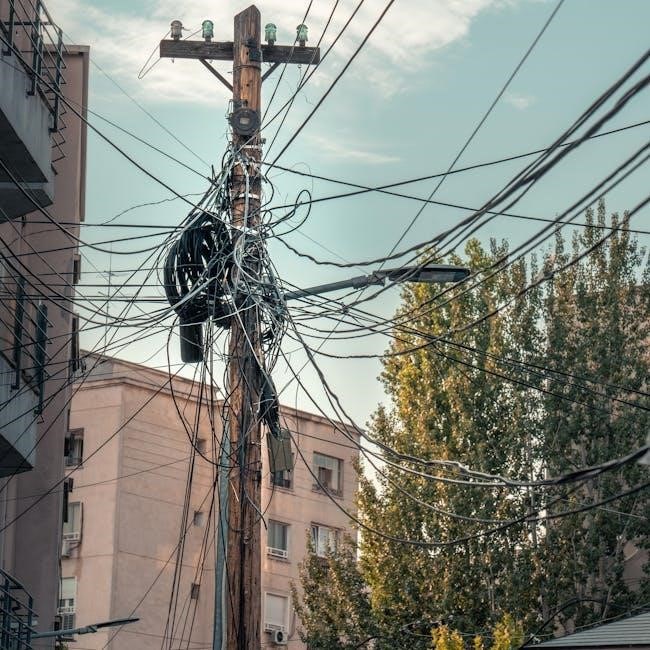
Testing the Cable
Testing ensures the cable functions correctly. Perform continuity tests to verify proper wire connections and check for shorts or opens. Use a cable tester to confirm performance.
Continuity Testing
Continuity testing verifies that each wire in an Ethernet cable has a clear path. Using a multimeter or cable tester, connect the tester to both ends of the cable. If the test shows infinite resistance, the cable has an open circuit. A short circuit will display low resistance between unintended wires. This ensures the cable is free from opens or shorts, crucial for reliable network connections. Proper continuity testing prevents issues like intermittent connections or no connectivity, ensuring optimal performance.
Performance Testing
Performance testing evaluates an Ethernet cable’s ability to transmit data at optimal speeds and quality. Tools like network testers measure bandwidth, signal strength, and latency. This ensures the cable meets required standards for applications like video streaming or VoIP. Testing identifies issues like signal degradation or interference, ensuring reliable connections. Proper performance testing confirms the cable supports intended data rates, maintaining network efficiency and user satisfaction. It is crucial for troubleshooting and validating installations in both home and professional environments.
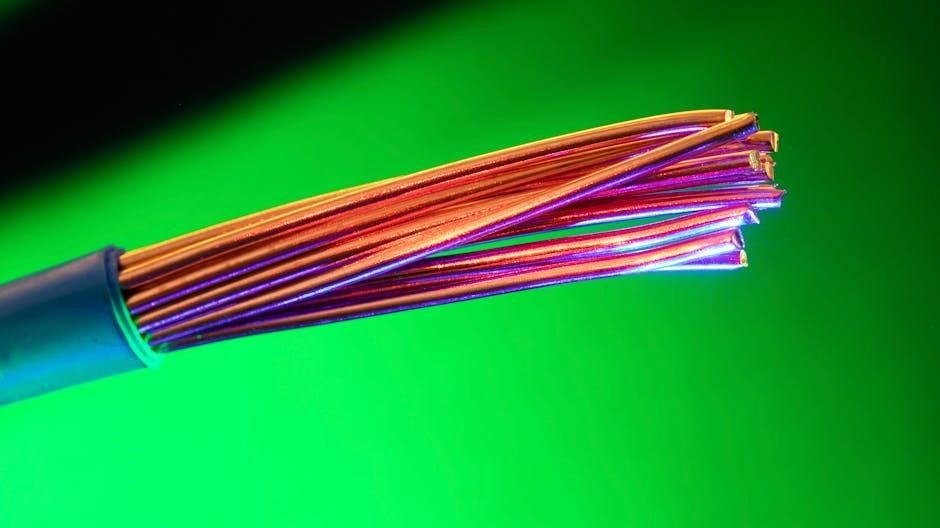
Installation
Ethernet cable installation involves running cables through walls or along floors, connecting them to routers, switches, and devices. Proper techniques ensure reliable connectivity and performance across networks.
Installing in Home Environments
Installing Ethernet cables in home environments requires careful planning to ensure reliable performance and safety. Begin by assessing the layout of your space and determining the most efficient cable paths. Use cable clips or raceways to secure wires along walls or floors, avoiding damage from furniture or foot traffic. Connect each device to a central hub or router, ensuring proper termination for optimal signal strength. Test connections to verify functionality and minimize interference from other household devices. Regularly inspect cables for wear and tear to maintain performance and safety standards.
Installing in Office Environments
Installing Ethernet cables in office environments requires meticulous planning to support high-speed communication and scalability. Begin by mapping out the office layout and determining the optimal cable routes, ensuring minimal interference and accessibility. Use cable management tools like trays or clips to organize wires neatly, preventing tripping hazards and maintaining a professional appearance. Connect devices to switches or routers strategically placed to minimize signal degradation. Consider using higher-category cables (e.g., Cat6 or Cat7) for future-proofing and faster data transfer rates. Test each connection post-installation to ensure reliability and optimal performance for all office systems.
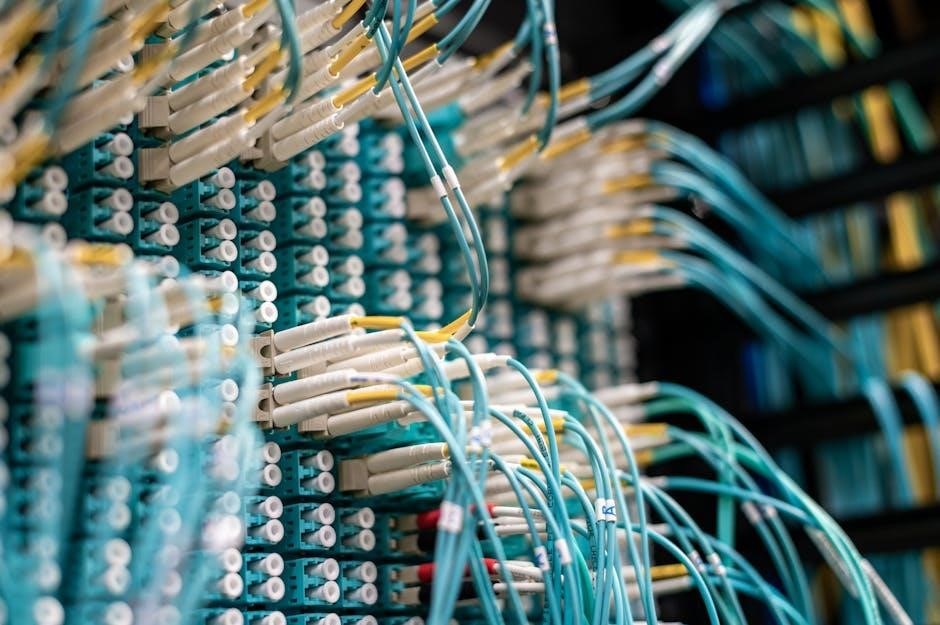
Network Configuration
Use standardized color coding for cables to simplify identification and organization. Apply clear labels to cables and ports, ensuring consistency across your network for easy troubleshooting and maintenance.
Setting Up Network Hardware
Setting up network hardware involves configuring routers, switches, and modems. Connect devices using Ethernet cables, ensuring secure and stable connections. Assign IP addresses manually or through DHCP for efficient network management. Verify firmware updates and configure settings like port forwarding or QoS for optimal performance. Label ports and organize cables to simplify future maintenance. Test all connections to ensure data flows correctly and troubleshoot any issues promptly.
Configuring IP Addresses
Configuring IP addresses is essential for enabling network communication. Assign static IP addresses to devices requiring fixed connectivity, such as servers, or use DHCP for dynamic allocation. Ensure unique IP addresses within the same subnet to avoid conflicts. Access network adapter settings to input IP details like subnet masks and gateways. Use tools like command prompts or network configuration utilities for verification. Proper IP configuration ensures seamless data transmission and connectivity across all devices in the network, optimizing performance and reliability. Always test connectivity post-configuration to confirm functionality.
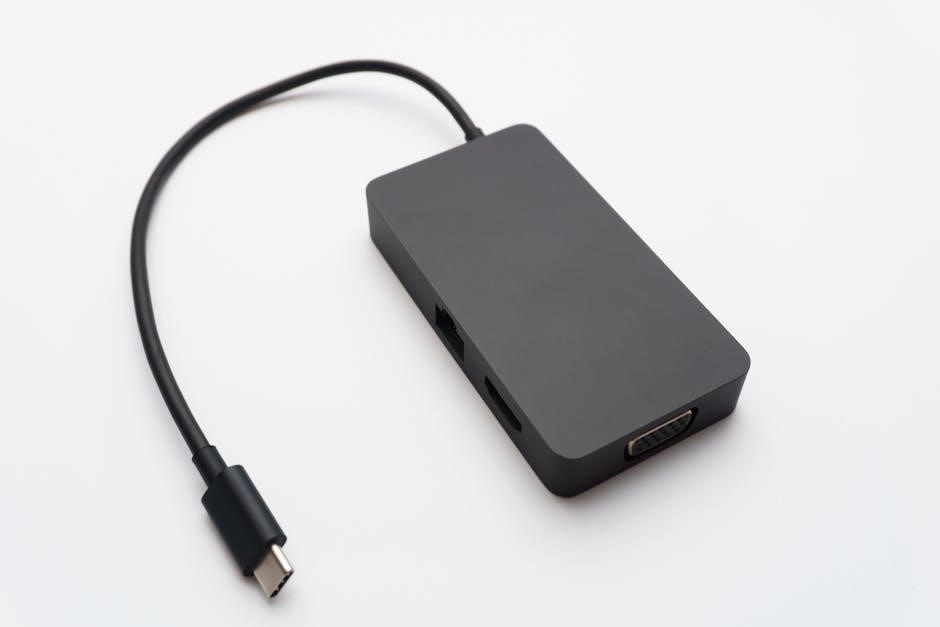
Troubleshooting Common Issues
Troubleshooting Ethernet cable issues involves identifying connectivity problems, checking for physical damage, and verifying proper connections. Ensure cables are securely plugged in and test for faults using diagnostic tools.
Identifying Common Problems
Common Ethernet wiring issues include physical damage, loose connections, or incorrect cable installation. Symptoms may involve slow speeds, dropped connections, or complete loss of connectivity. Damaged cables, improper termination, or interference from nearby devices can also cause problems. Additionally, mismatched cable categories or incorrect network configurations may prevent devices from communicating effectively. Identifying these issues often requires testing with diagnostic tools and visually inspecting cables for damage or wear. Addressing these problems promptly ensures reliable network performance and minimizes downtime.
Using Diagnostic Tools
Diagnostic tools are essential for identifying and resolving Ethernet cable issues. Cable testers can verify continuity, detect open circuits, and check for shorts. Multimeters measure cable resistance and identify faults. Network analyzers assess performance metrics like signal strength and latency. Additionally, software tools like ping and traceroute help diagnose connectivity problems between devices. These tools enable technicians to pinpoint issues such as damaged cables, incorrect terminations, or interference. Regular use of diagnostic tools ensures reliable network performance and helps maintain optimal connectivity across all devices.
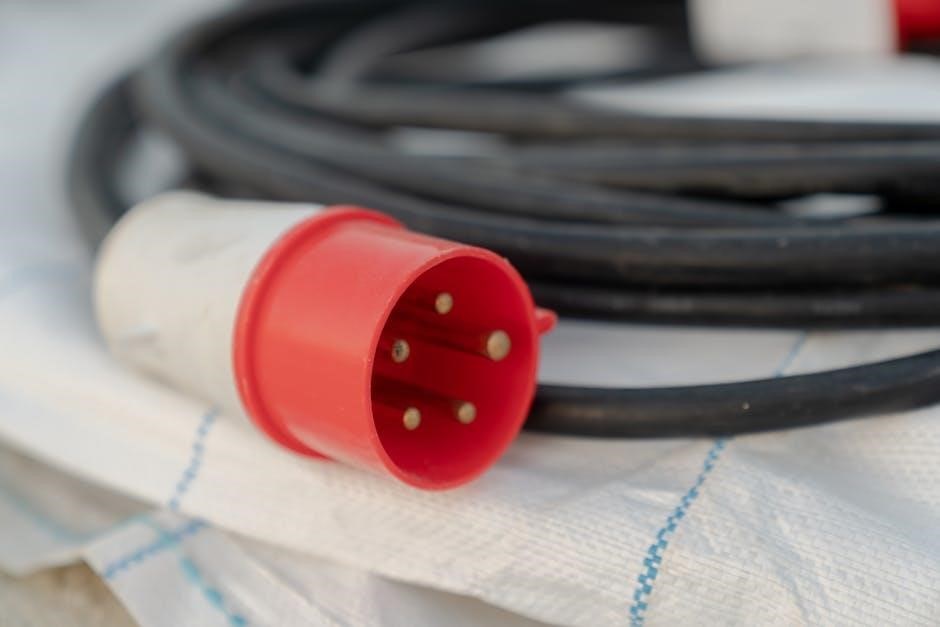
Security Considerations
Secure Ethernet cable installations by protecting physical access to cables and switches. Use encryption for data transmission and implement firewalls to prevent unauthorized network access and breaches.
Physical Security Measures
Physical security measures are crucial to safeguard Ethernet cables from tampering or damage. Install cables in secure locations, such as behind locked panels or along walls, to prevent unauthorized access. Use protective coverings like conduits or cable sleeves to shield wires from environmental hazards. Secure network hardware, such as routers and switches, in locked rooms or cabinets. Regularly inspect cables for signs of damage or interference. Restrict physical access to network components to prevent intentional or accidental disruptions, ensuring a stable and secure connection.
Data Security Best Practices
Data security is vital to protect sensitive information transmitted over Ethernet cables. Always use encryption protocols like SSL/TLS or IPsec for secure communication. Ensure network devices, such as routers and switches, are configured with strong passwords and updated firmware. Regularly monitor network traffic for suspicious activity and implement firewalls to block unauthorized access. Segment the network to isolate sensitive data and use VPNs for remote connections. Schedule regular security audits to identify vulnerabilities and address them promptly to maintain a robust and secure network environment.

Best Practices
Adopt cable management techniques to organize and protect Ethernet cables. Labeling and proper documentation ensure easy maintenance and troubleshooting, promoting a reliable and scalable network infrastructure.
Cable Management Techniques
Efficient cable management is crucial for maintaining a tidy and functional network setup. Use cable ties, clips, or raceways to secure and organize Ethernet cables, preventing tangles and damage. Properly routing cables behind walls or along baseboards minimizes visibility and reduces tripping hazards. Labeling cables at both ends ensures easy identification and simplifies troubleshooting. Regularly inspecting and updating cable layouts helps maintain performance and adaptability. A well-organized system not only enhances safety but also improves airflow in server rooms and supports future network expansions.
Labeling and Documentation
Proper labeling and documentation are essential for maintaining a clear and functional Ethernet cable setup. Label each cable at both ends with its purpose, destination, and connection details to ensure easy identification. Use standardized naming conventions and color coding to enhance readability. Maintain a comprehensive documentation log, including network maps, cable routes, and port assignments. This documentation aids in troubleshooting, future upgrades, and ensures continuity for network administrators. Clear labeling and detailed records reduce downtime and streamline maintenance, making the system more scalable and manageable over time.
Future-Proofing Your Installation
Future-proofing ensures your Ethernet installation adapts to evolving technology. Use high-quality cables and modular designs to accommodate higher bandwidth demands and seamless upgrades as needs grow.
Upgrading for Higher Speeds
Upgrading Ethernet cables for higher speeds ensures your network stays efficient as technology advances. Consider installing Category 6 or higher cables, which support faster data transfer rates like 10 Gbps. Using modular connectors allows for easy upgrades without rewiring. Plan for scalability by running extra cables during installation. Regularly test performance to identify bottlenecks. Stay informed about emerging standards, such as Cat 7 or fiber optics, to prepare for future upgrades. Investing in quality materials and flexible designs ensures your network remains robust and adaptable to increasing bandwidth demands.
Planning for Scalability
Planning for scalability ensures your Ethernet cable installation adapts to future demands. Install extra cables during initial setup to accommodate growth. Use higher-category cables (e.g., Cat 6 or Cat 7) for better bandwidth and compatibility with emerging technologies. Modular connectors simplify upgrades without rewiring. Consider redundant connections to critical devices for reliability. Plan for potential network expansion by mapping future hardware needs. Regularly review and update your network diagram to reflect changes. Scalable designs reduce costs and downtime during upgrades, ensuring your system remains efficient and future-ready.
Budgeting for Your Network
Budgeting for your network involves estimating material costs, labor, and future upgrades. Prioritize quality components for reliability while balancing affordability. Plan for scalability to avoid costly upgrades later.
Estimating Material Costs
Estimating material costs involves listing all required items, such as Ethernet cables, connectors, patch panels, and faceplates. Determine quantities based on network size and device count. Research prices using search queries like “Cat6 cable prices” or “Ethernet connectors bulk” to find cost-effective options. Consider future scalability by purchasing slightly extra cable lengths. Balance affordability with quality to ensure reliability. Tools like cable testers may also be needed. Compare suppliers to secure the best deals, ensuring budget efficiency without compromising performance.
Considering Labor Costs
Labor costs vary based on the complexity of the installation and the technician’s expertise. For small projects, DIY setups can save money, but larger installations may require professional help. Hourly rates for network technicians typically range between $50 to $150, depending on location and experience. For complex wiring, such as running cables through walls or ceilings, additional charges may apply. Plan for potential overtime and ensure contractors provide detailed quotes. Factors like network size and cable routing complexity also influence labor expenses, so budget accordingly to avoid unforeseen costs during installation.
Safety Precautions
Always wear protective gear and avoid live wires. Handle cables carefully to prevent physical damage. Ensure proper grounding and follow electrical safety guidelines to minimize risks.
Handling Cables Safely
When handling Ethernet cables, ensure you avoid excessive bending or twisting, as this can damage the internal wiring and degrade performance. Always grasp the cable by the connector or jacket, never by the wires themselves. Keep cables away from sharp objects and high-temperature sources to prevent damage. Regularly inspect cables for signs of wear or fraying and replace them if necessary. Proper handling extends cable lifespan and ensures a stable network connection for reliable data transmission.
Electrical Safety Tips
Avoid working on live circuits and ensure all power sources are disconnected before handling Ethernet cables. Use insulated tools to prevent electrical shocks. Keep cables away from water and moisture to prevent short circuits. Never overload circuits or use damaged outlets, as this can lead to electrical hazards. Always follow local safety codes and guidelines when installing or maintaining network infrastructure. Prioritizing electrical safety protects both personnel and equipment, ensuring a secure and reliable networking environment.
Proper Ethernet cable wiring ensures reliable connectivity, enhances performance, and supports future network demands. Adhering to best practices guarantees a secure, efficient, and scalable networking solution for all environments.
Ethernet cable wiring is a critical process requiring careful planning and execution. Proper installation ensures reliable network connectivity, minimizing interference and downtime. Key steps include assessing network requirements, selecting the right cable category, and using appropriate tools for termination and testing. Adhering to best practices, such as cable management and labeling, enhances performance and scalability. Regular testing and troubleshooting are essential for maintaining optimal network function. Future-proofing installations by upgrading cables and planning for scalability ensures long-term efficiency and adaptability to evolving technological demands.
Encouragement for Proper Wiring
Proper Ethernet cable wiring is crucial for ensuring reliable network performance and minimizing potential issues. Investing time and effort into correct techniques and best practices pays off in the long run. A well-planned and neatly installed network not only enhances efficiency but also supports future upgrades. Avoiding shortcuts and adhering to standards ensures optimal connectivity and reduces the risk of frequent disconnections or data loss. By prioritizing quality and organization, you create a robust foundation for your network, making it more scalable and easier to maintain over time.
Additional Resources
Explore online guides, forums, and tutorials for in-depth Ethernet wiring insights. Visit manufacturer websites for detailed specifications and troubleshooting tips. Join networking communities for expert advice and shared experiences.
Recommended Online Guides
For comprehensive insights, explore reputable online guides specializing in Ethernet cable wiring. Websites like Cisco, Ubiquiti, and Reddit’s networking communities offer detailed tutorials. Manufacturer-specific guides provide precise instructions for their products. Platforms like YouTube feature hands-on videos, while forums share real-world experiences. These resources cover everything from cable termination to advanced network configurations. Utilize these guides to enhance your understanding and ensure professional-grade results. They often include troubleshooting tips, best practices, and expert recommendations for optimal performance.
Community and Forums
Engaging with online communities and forums can provide valuable insights and practical advice. Platforms like Reddit’s r/networking and Stack Overflow host discussions on Ethernet cable wiring. Users share experiences, troubleshooting tips, and best practices. These communities often include IT professionals and enthusiasts offering expert advice. Participating in forums allows you to ask specific questions and receive tailored solutions. Additionally, many forums archive common issues and solutions, creating a wealth of knowledge for beginners and experienced technicians alike. Active engagement fosters learning and helps resolve complex wiring challenges efficiently;